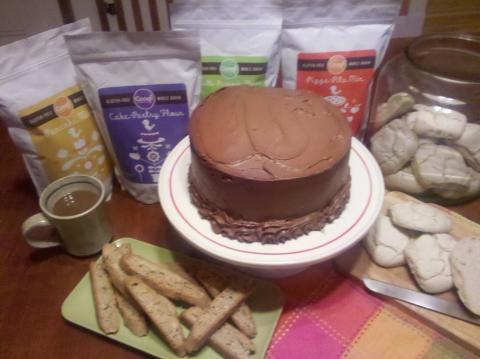Submitted by davidadmin on Mon, 11/23/2015 - 14:28
Gluten-Free Food Revolution

Jamie Oliver is one of my heroes, so forgive me if I blatantly rip off his movement’s tagline. I so completely support his mission of improving the quality of food in schools, in stepping up everyone’s awareness of both real food nutrition and its impact on health, and imparting food prep skills to anyone who eats. There are detractors and critics, as there always will be, and to be sure, the delivery model of reality TV at times raises more questions than it answers, but for the size of audience alone and for taking on this important mission, I say, Go Jamie!
I have a corollary revolution of my own to foment (sadly, without the powers of network television behind me). I eat gluten-free, and have for a number of years, along with my family of four. We have grown familiar with the social limitations we face at places like restaurants and kids’ birthday parties, and for the most part, we accept these restrictions (opportunities for creative alternatives!) with a modicum of grace. Indeed, in the last couple years or so, we have witnessed a sea change in general awareness of gluten-free. There are a lot more options on grocery shelves, and places like restaurants have, in many cases, become more accommodating of our dietary needs. For all this, I am appreciative and grateful. My children can travel in the world of kids and not feel like outcasts.
But yet I am dismayed. Just as Jamie Oliver winces at the capacity of the USDA to assess the nutritional value of a French fry as superior to that of freshly sautéed mixed veggies, so do I balk at the willingness of our movement promoting awareness of gluten intolerance to embrace gluten-free foods devoid of nutritional value. If you don’t believe me, just take a look at the ingredients posted on the label of any packaged gluten-free item, be it bread mix, pretzels, cookies, bagels, pizza crust, you name it: the primary ingredients are likely to be rice flour (this means white) and tapioca starch and/or cornstarch (processed carbohydrates). Even those products containing whole grains like brown rice flour or sorghum flour tend to list them after these highly processed ingredients, which means they appear in much smaller proportion than the ingredients listed first. Let’s face it—the array of gluten-free “foods” currently on the market are no better for us than those school lunch French fries
Another discouraging trend is the use of bean flours, in particular fava and garbanzo. Sally Fallon, director of the Weston Price Foundation, teaches us that beans are only digestible by humans after extensive soaking and/or fermentation, to neutralize mineral blockers and enzyme inhibitors. True, beans can be a powerhouse of protein, vitamins, and fiber, but these benefits can only be derived from beans we actually digest. Ground raw beans, bean flour, is an unsoaked bean product. If you, like me, experience an unpleasant aftertaste when you eat gluten-free baked goods made with a significant proportion of bean flour, that bitter flavor may be your body telling you this is not a food you should be consuming.
What then, should we eat? Enter whole grains!! If you think that the world of whole grains is available only in the form of “whole wheat”, you are missing out on a significant component of a gluten-free diet. To be sure, you can live without flour products entirely, and some alternative health care providers in fact recommend doing so. However, I’m more of a realist, in addition to being someone who rather enjoys a fabulous baked treat or slice of pizza—I don’t want to cast these delicacies from my life, I merely want to enjoy them in a way that is good for me: whole grains.
There is a very long list of gluten-free grains, any one of which can be consumed in its entirety, hence, “whole.” Brown rice, sorghum, millet, quinoa, amaranth, teff, buckwheat, corn, and gluten-free oats will start the list. Take your pick, mix and match, grind them up, and voila! You have a fabulous whole-grain gluten-free flour, from which you can experiment to make any gluten-free recipe you want. I concede (reluctantly, but inevitably) that for most gluten-free flour-based foods, it is a “necessary evil” to include some fraction (I generally allow for 1/3) of processed starch products, in addition to the whole grain flours. This is because gluten-free baking is just a different animal than traditional wheat flour baking, which calls forth the gluten to make for supple and fluffy results. With gluten-free baking, you do need to simulate some familiar tastes and textures, and I have concluded for myself that the net result of delicious yet still 2/3 whole grain goodness is a completely acceptable equation.
Which brings me to the shameless self-promotion portion of this lengthy exposition. Think delicious, nutritious, and gluten-free can’t go hand in hand with baked goods? Think again! Cooqi Gluten-Free Baking Mixes are all formulated to deliver that maximum 1-2 taste and good-for-you punch. Want a delicious slice of bread? Outrageous pizza crust? Worth-waking-up-for pancakes? A droolable hunk of cake? Have them!!! All as close (and morally/nutritionally redemptive) as your nearest bag of Cooqi mix. And, after you get yourself nice and comfy with the process of mixing a few ingredients and putting them in the oven, you can start going crazy and getting all creative, and see what fantastical creations you can call forth. Yes, you can do all this, and still be good to yourself.
Gluten-free and good for you. Feed your body, and feed your soul too. Welcome to the Revolution!
